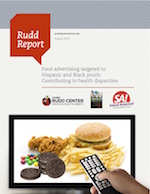 A new study led by Jennifer Harris, an associate professor in residence at the Rudd Center for Food Policy & Obesity at the University of Connecticut, finds that food and beverage companies disproportionately target Black and Hispanic youths in their marketing efforts for fast food, candy, sugary drinks, and snack foods. In contrast, the companies are less likely to target Black and Hispanic youths in their marketing efforts for healthy foods, according to the report.
A new study led by Jennifer Harris, an associate professor in residence at the Rudd Center for Food Policy & Obesity at the University of Connecticut, finds that food and beverage companies disproportionately target Black and Hispanic youths in their marketing efforts for fast food, candy, sugary drinks, and snack foods. In contrast, the companies are less likely to target Black and Hispanic youths in their marketing efforts for healthy foods, according to the report.
Researchers analyzed the advertising of 26 major restaurant, food, and beverage companies during 2013. All of the companies spent at least $100 million on advertising that year. The analysis looked at dollars spent on advertising on television shows with large audiences of Black and Hispanic youths. One key finding of the study was that Black youth viewed 70 percent more food-related TV advertising compared with their White peers. In addition, they saw almost twice as many TV ads for candy, soda and other sugary drinks, and snacks.
“Our analysis of the largest food, beverage, and restaurant corporations in the United States shows that these companies vary widely in their focus on advertising targeted to Black and Hispanic youth,” says Dr. Harris. “Unfortunately, the majority of brands targeted to youth of color are nutritionally poor products that can be harmful to their health.”
The report, Food Advertising Targeted to Hispanic and Black Youth: Contributing to Health Disparities, was funded by a grant from the Robert Wood Johnson Foundation. It may be downloaded by clicking here.












If these findings could withstand legal scrutiny, I think it would only be fitting if a class action lawsuit was filed against the food and beverage industry for selling products they will result in obesity, high blood pressure, heart ailments, ADHD, etc.
Let us start by exposing these various companies and their practices. Let us also start exposing to wider vistas of food other than the trying and not too true bounty of schlock noshes.
I’m curious to know whether or not the researchers controlled for the amount of television watched by each group (participant), which would certainly impact the number of times any one participant would have had the opportunity to view tv ads displaying poor food choices.
If one participant watched more tv ads than another, then it stands to reason that that participant would have been exposed to seeing more ads displaying poor food choices than others who may have watched less tv in general.